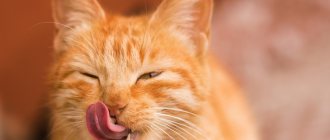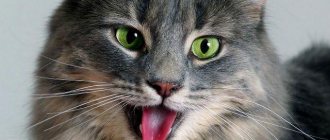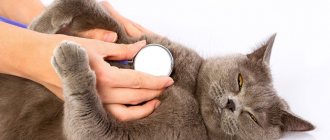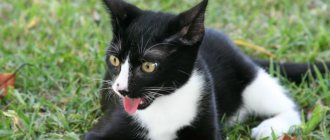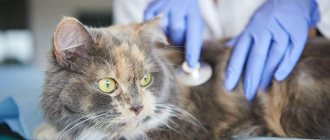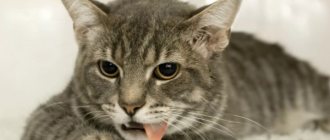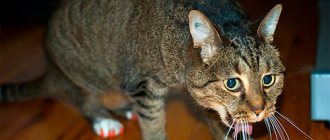13459Administration
If the cat is breathing heavily and wheezing, then this indicates a serious illness. It is necessary to pay attention to the characteristics of the symptoms. For example, when a cat breathes normally, the animal's chest rises and falls. In this case, the process occurs calmly, without jerks or convulsive movements.
However, if the cat begins to breathe from the stomach and sides, this means a disruption in the functioning of the respiratory tract. It is painful for the animal to exhale and inhale, as it does in a normal state. An even more alarming syndrome is when wheezing is added to the symptoms listed above.
© shutterstock
Respiratory process of a cat
A cat's breathing directly depends on its physical and psychological state. A healthy cat does not wheeze, breathes evenly, calmly, and inaudibly. If problems arise, she is unable to draw air into her lungs and her sighs become intermittent, as if coming from the “stomach.” There are a number of factors that influence the frequency of the process, in which there is no point in worrying too much:
- Stress due to rage, fear, joyful excitement - the frequency increases for a short time.
- Often a kitten wheezes when breathing if it has swallowed its own fur.
Also, do not forget why a kitten wheezes when breathing when he falls asleep soundly. This indicates complete relaxation. At the same time, his pulse and heart beats many times faster than that of an adult.
Why is there a problem?
Pulmonary causes and additional symptoms
Cough is one of the main symptoms of rhinotracheitis in an animal.
If the kitten does not meow and its respiratory rhythm has changed, then in most cases the problem is associated with pathologies of the respiratory system. Many pulmonary diseases are characterized by copious secretion of saliva and mucus, which the pet often swallows. If a cat is breathing heavily and wheezing constantly, then this indicates a number of pathologies presented in the table.
| Disease | Short description | Additional symptoms |
| Rhinotracheitis and calcivirosis | The mucous membranes of the respiratory tract and intestines become inflamed | Heat |
| Diarrhea | ||
| Cough and severe wheezing | ||
| Ulcers on the mucous membranes | ||
| Purulent and mucous discharge from the eyes and nose | ||
| Pneumonia | Inflammatory reaction in the lungs associated with viruses and bacteria | Barking type cough |
| Temperature increase | ||
| Deterioration of general condition | ||
| Bronchial asthma | Chronic inflammation of the airways with narrowing of the pulmonary lumen | Frequently pressing the cat to the floor |
| The animal is breathing hoarsely and coughing | ||
| In advanced cases, the pet suffocates | ||
| Helminthiasis | Associated with the entry of small parasites into the respiratory tract | Vomiting and nausea |
| Breathing with wheezing | ||
| Broken stool | ||
| The pet eats almost nothing | ||
| Cancerous tumors | Accompanied by the proliferation of malignant cells in the respiratory organs | The cat grunts and sniffles when it breathes |
| Changed voice, and sometimes meowing disappears completely | ||
| Shortness of breath and cough with bloody impurities | ||
| Laryngeal edema or laryngospasm | Occurs against the background of poisoning with household chemicals, an allergic or autoimmune reaction | Acute lack of oxygen |
| Restless state | ||
| The cat meows hoarsely and moans often |
Other reasons can also affect heavy breathing in a cat and severe wheezing:
The animal may experience difficulty breathing due to the triplication of the skull.
- foreign body entering the throat;
- brachycephalic syndrome;
- pulmonary edema;
- congenital anomalies;
- tracheal collapse.
Non-respiratory sources
When a cat has hoarse breathing accompanied by a loud sound, this does not always signal a pathology in the respiratory system. Often a cat grunts and breathes through his mouth due to the following disorders:
- Protrusion of the diaphragmatic hernia. The symptoms are reminiscent of bronchial asthma, with the pet constantly being in one position and breathing heavily.
- Heart diseases. In case of heart failure, the animal rarely develops a cough, and the cat often wheezes and breathes through his mouth. Arrhythmia, myocardosis and myocarditis can affect impaired breathing.
- Severe renal failure. The pathology often provokes pulmonary edema, as a result of which the pet refuses to eat, is constantly in a semi-sitting position and coughs.
Symptoms
A life-threatening sign is intermittent inhalation and exhalation with coughing.
- Cat wheezing - manifested by noises, whistling due to narrowing of the airways. They arise both due to the accumulation of excess fluid - hydrothorax, and a large amount of air - pneumothorax. With obstruction, gurgling sounds may be observed in whistling and wheezing.
- Coughing is a protective reaction due to which the respiratory canals are cleared of foreign objects, pus, mucus, fluid and other irritants. May occur due to a cold or have other dangerous causes.
- When breathing, the cat not only wheezes, but also has hoarseness - a very dangerous symptom. The voice may deepen due to the growth of a malignant neoplasm, and a cough with blood clots in the mucus may additionally appear, and the cat wheezes when breathing.
Causes of wheezing with heavy breathing
This is noisy bubbling breathing. It can occasionally be caused by a cold, and also accompanies most diseases of the respiratory system. A cat often wheezes for the following reasons :
- foaming of accumulated liquid (blood, trans- or exudate);
- the gaps in the respiratory tract narrow.
When the animal loses its voice, it wheezes for a long time. This indicates a violation of the vocal cords, their incomplete closure. The animal will wheeze until they are fully recovered. This phenomenon occurs when mucous fluid accumulates in crevices or with laryngitis.
Changes in a cat's breathing may be a consequence of obesity. In this case, even after little physical activity the animal breathes heavily. Sudden wheezing may indicate that the cat has swallowed a foreign body that is stuck in the throat. You can't try to pull it out on your own. Why can't pet owners do this? Without qualified help, the object can be pushed even further and the animal will die.
Causes
Why does a cat wheeze or cough when breathing? There are many factors that cause problems, and a caring owner needs to study them.
- The inflammatory process can be localized in several lobes of the lung tissue and lead to lobar disease - fibrotic pathology.
- Calcivirosis - the symptoms and nature of development are similar to the symptoms of human influenza.
- Rhinotracheitis – the second name for “feline herpes”, is transmitted through contact.
- Laryngospasm is involuntary muscle contractions in the larynx due to an allergic reaction to a food, plant, or chemical.
- Tumors in the bronchi.
- Injury to the larynx with a sharp object.
- Feline bronchial asthma.
In a cat, wheezing when breathing can be accompanied by cyanosis - the mucous membrane becomes bluish due to a lack of oxygen in the tissues. The animal presses itself to the floor, clenches its paws, and stretches its neck.
Other causes of severe wheezing and hoarseness in a cat may include:
- hernia in the diaphragmatic zone;
- diseases of the cardiovascular system;
- swelling in the lungs due to kidney failure.
The cat wheezes when he breathes in the presence of helminthic infestations, which is a common problem for four-legged animals.
Signs and types of wheezing
When observing how a pet coughs, one involuntarily draws an analogy with a human cough. But unlike a person, when coughing they stand in a certain position, stretching their neck forward as much as possible, making sounds reminiscent of an attack of vomiting.
By its nature, the cough mechanism is carried out as a result of strong irritation of the receptors of the mucous membrane lining the respiratory tract (nasal passages, bronchial tree or the lungs themselves).
Quite often, the cause of a severe cough in a cat is inflammatory processes occurring in the respiratory tract. As a result of a developed pathological process, a large accumulation of a specific secretion – mucus – occurs in the lumen of the larynx.
The body is trying to get rid of the irritating factor. A signal is transmitted to a certain center of the brain, transmitted along nerve endings, provoking irritation of the cough center. From this center impulses go to the larynx. Against the background of this process, the muscle fibers located in the larynx under the influence of the reflex contract.
When exhaling, the glottis is open, which is why a specific sound called a cough occurs. The owner’s task is to promptly detect such a sound being made and the posture being taken. This will make it possible to promptly contact a specialist for help, preventing the development of possible complications.
It is necessary to know what types of cough exist in veterinary medicine, their characteristic features and the consequences they have for the normal condition of the pet.
Veterinarians divide cough in domestic cats into several types. The cough can be acute or chronic.
The acute form of cough is characterized by a sudden appearance of the reflex, and the duration ranges from several days to 1 week.
A chronic type of cough can last from several weeks to several months.
Coughs are also classified according to their sound - muffled and loud, and according to the nature of the accompanying discharge - dry or wet.
In turn, the dry type of cough has its own symptoms. The cat wheezes, and the cough that escapes is abrupt and loud.
The wet type of cough is characterized by the appearance of peculiar gurgling sounds, accompanied by the release of mucous secretions, sputum, or even blood.
The time of day when a dry or wet cough appears is completely unimportant.
With a weak cough, the animal does not particularly strain. But for a strong one, the following clinical picture is typical - the cat coughs and wheezes, stretching out and snuggling, as if she had nausea and vomiting.
The pet owner should note any peculiarities when the cat coughs, which will allow the veterinarian to create a more accurate picture of what is happening when collecting an anamnesis and determine the exact factor that provoked the pathology. In addition, a detailed medical history makes it possible to choose the correct and most effective treatment tactics.
If there is not only a cough, but also a stuffy nose in a cat, this type of pathological process is called respiratory. Body temperature may increase, and the general condition is depressed.
A set of symptoms along with a cough may indicate the onset of an inflammatory process in the lungs or bronchial tree. Characteristic symptoms do not appear immediately, but after a certain period of time. With increasing symptoms, the cough will be loud and dry, without secretions of specific secretions, sputum and blood.
Another type of cough is also defined in veterinary medicine – cardiac. The cardiac type of cough develops due to pathological processes occurring in the myocardium. This cough is not accompanied by the production of sputum and mucus.
The main cause of cardiac cough is severe thickening of the myocardial walls or the accumulation of pathological exudate in the pulmonary structures, provoked by disturbances in the circulatory system. With a cardiac cough, the following symptoms are observed - the cat is breathing heavily, as if she does not have enough air. Instead of nasal breathing, inhalation through the mouth is noted.
A cough can occur as a result of irritation of the mucous membranes by foreign protein components - an allergic reaction. With a weak reaction, the pet may simply cough from time to time, and there may be discharge from the nose.
Severe allergies can cause coughing to such an extent that the animal begins to choke. In such cases, it is necessary to urgently contact a 24-hour veterinary clinic for immediate help.
First aid
If the animal suddenly stops breathing, it is necessary to perform chest compressions and artificial respiration. Place the pet so that the neck is an even continuation of the spine.
- Clean the mouth from excess mucus, saliva and foreign objects and close it.
- The palms form a tube to inhale air into the cat’s nose; the frequency of inhalations should depend on the size of the animal. Up to 20 breaths should be taken within one minute. If the kitten is small, then the frequency must be reduced, otherwise there is a high risk of damage to the pet’s lungs due to the large volume of air.
- If rhythm is completely lost, you need to do an indirect massage. Place the palm of one hand over your chest so that your thumb moves away from the rest. Rhythmically clench and unclench your fingers 5 times - exhale into your pet’s nose. In this case, you should check your pulse every 2 minutes.
Prevention measures
To prevent your cat from wheezing, you need to regularly monitor his health and regularly visit the veterinarian. Timely deworming and vaccination help reduce the likelihood of difficulty breathing. In most cases, wheezing is recorded due to disorders of the respiratory tract. To prevent such diseases, you should not allow hypothermia and give your pet cold food and water. It is important to eliminate all possible allergens and monitor the animal so that it does not ingest any foreign objects. If you have difficulty breathing or other alarming symptoms, you should not self-medicate, but should immediately contact a veterinarian so that your pet does not die.
Treatment
To keep your cat healthy, you need to periodically take him to the doctor. Only a specialist can determine why a cat wheezes when he breathes. It is also important to carry out all types of vaccinations, monitor hygiene, and add vitamins to the diet.
The veterinarian identifies the causes of wheezing in a cat when breathing and knows how to treat inflammatory, viral, and bacterial infections.
- Helminths are removed by a course of treatment with special means. Antiparasitic drugs are toxic and cause serious damage to the animal's liver, kidneys and other organs, including death. For this reason, dosage and supervision by a veterinarian are important, especially if the kitten is wheezing or coughing.
- A cough can be triggered by a common allergic reaction, either to a food product or to a chemical or plant. Bronchial asthma occurs and is eliminated with the help of drug therapy, antioxidants, vitamins and a special inhaler.
- The cat wheezes - problems in the cardiovascular system occur mainly in overweight and old cats. An examination by a veterinarian, examination using electrocardiography and x-rays are required. Appropriate treatment and dietary type of food are prescribed.
It is strictly not recommended to self-medicate; an animal’s body is as fragile as a human’s. This is the same family member whose life should be in the hands of an experienced specialist.
Diagnostics
At the appointment, the doctor may examine the animal’s throat.
If your cat becomes hoarse, breathes with its tongue hanging out, and sneezes frequently, then you should immediately contact a veterinary clinic. Such symptoms indicate serious illnesses in the respiratory and other systems of the cat’s body. During diagnosis, a specialist uses special instruments to examine the animal’s throat to detect a foreign object, which most often leads to wheezing. The veterinarian asks the animal owner what other symptoms have been present and for how long. If the cat begins to breathe heavily in its stomach, wheeze and cough, then to make an accurate diagnosis and find out the cause of the problem, the following diagnostic procedures are performed:
- laboratory testing of blood and urine;
- analysis of feces for the presence of helminths;
- biopsy of damaged tissue;
- ultrasound diagnostics;
- radiography.
Diagnosis of the respiratory system: how a veterinarian determines the presence of diseases
Most often, diagnostics of the respiratory system is carried out using a combined method; a specialist can use several methods at once:
- Auscultation (listening to the chest organs). All you need is a phonendoscope. The method allows you to detect wheezing in the lungs and bronchi.
- Percussion (tapping the chest). In this case, an experienced specialist can quite accurately determine the boundaries of organs, the presence/absence of fluid, etc. Note that the study can give good results only in cases where the qualifications of the specialist performing percussion are sufficiently high.
- X-ray. The technique is simple and cheap; equipment for its implementation is available in almost every large veterinary clinic. However, sufficiently high-quality images can be obtained only if special contrast compounds are introduced into the animal’s blood before the study. The pictures are clearer and it is easier to notice signs of pathologies.
- Ultrasound examination of the chest organs. The technique is also common and, moreover, can provide better data, since the method is excellent for soft tissue studies. But ultrasound is a method, the result of which depends even more on the qualifications of the performer. Therefore, the breeder’s task is to select a really good specialist.
The cat is breathing heavily: how to provide first aid?
The animal should be observed. If abdominal breathing is associated with physiological reasons, it will pass within half an hour. You need to come to terms with abdominal breathing associated with pregnancy or lactation; this is a normal phenomenon. If your pet gets sick in a car, you need to stop and wait until the animal comes to its senses.
Special remedies have been developed against motion sickness. Veterinarians recommend giving 1 ml of Vetspokoin suspension or a drop of Stop-Stress per 1 kg of weight a couple of hours before the trip.
If heavy breathing is caused by hot weather, then the pet is moved to a cool place or the air conditioner is turned on, but so that the cold air does not fall on the cat. Otherwise, shortness of breath will occur due to bronchitis or rhinitis.
In all other cases, the animal must be shown to a veterinarian. Above we have given a fairly comprehensive list of problems, most of which only a doctor can identify and help the animal.
Be sure to read:
Why does a cat have blood from under its tail: is it flowing or dripping, what should the owner do, should he worry?
Tags
if a cat coughs a panting cat in a cat licking fur, this is a cat before If a cat is not an adult cat can If a cat is in a hurry about a dog about a dog Dog breeds Dog health Dog nutrition Dog training Dog health behind a dog Why is a dog afraid of Dogs in cats. cat deaths occur in cats and Cat breeds Cat health Cat nutrition Cat behavior Health cats in cats and in cats and
dogbreedrodentsarticlerespiratoryservicesopen questioncontentsurgeonanswervaccinationbirddepartment
Treatment in clinical and home settings: which therapy is preferable
For diseases of the respiratory system, cat treatment can be used both clinically and at home. Note that only the simplest operations can be performed at home, and in case of serious illnesses such treatment is completely contraindicated.
The owner can do the following independently:
- Give antibiotics.
- Give bronchodilators and mucolytics.
In other cases, treatment can only be carried out in a clinical setting:
- For cancer, foreign bodies and tracheal collapse, surgery is indicated. The same goes for all serious chest injuries.
- For pneumonia and bronchitis, complex broad-spectrum antibiotics are prescribed. In order for the treatment to be effective, pre-seeding is done on nutrient media and the type of pathogen is accurately determined.
- Asthma attacks are treated with powerful antispasmodics and bronchodilators. The veterinarian’s task is to select the minimum effective dose, since the animal will have to “sit” on these drugs for the rest of its life.


